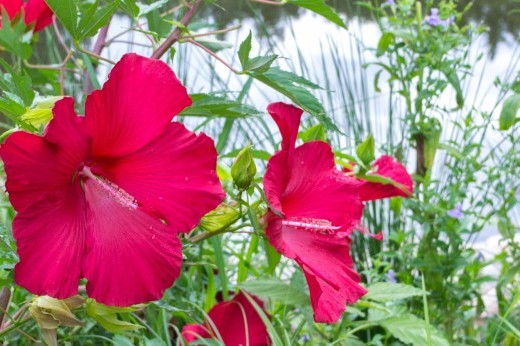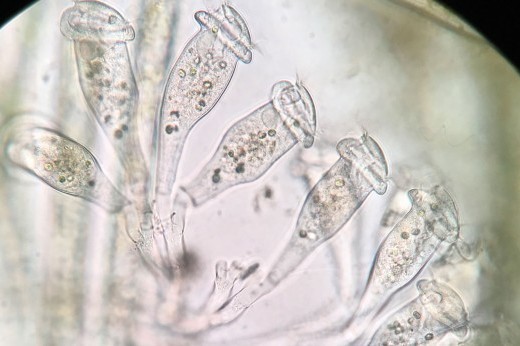Algae love warm weather. High temperatures and long the days create perfect conditions for their growth. These photos are from a water sample I took from the Shelby White and Leon Levy Water Garden in high summer. At the time, the forebay (upper pond) was thick with an emerald-green slime. I scooped some up to take a look.
Back at the lab, I took a look at the sample and discovered that it is a bloom of Hydrodictyon, a genus of colonial green alga. This green slime is stunningly beautiful when you get it under the microscope.
Colonial algae are made up of many genetically identical cells, and the cells in a Hydrodictyon colony grow in a repeating polygonal pattern that forms a tube shape or a net. Appropriately, its common name is the water net.
Being a colonial organism means that every cell in the colony is capable of the same behaviors. In a multicellular organism, there is specialization of cellular behavior. We humans are, of course, multicellular. Some of our cells are skin cells, some are blood cells, some are sex cells and produce the gametes that will go on to make the next generation. The list goes on. Each cell type is specialized and carries out a distinct role in our body.
In a Hydrodictyon colony, every cell is a vegetative cell and a sex cell. They all function to keep the colony alive, and each cell can also produce its own new colony. The mother cell produces many nuclei, packaging each one up inside a membrane. When the new individual cells have arranged themselves into a polygonal colony identical to the parent, the mother cell breaks open to release it. This new colony is much smaller than the old—it has to be to fit inside a single cell of the old colony! From there the cells of the new colony expand and grow until they are ready to produce another generation themselves.
Hydrodictyon isn’t the only green algae living and making babies in the Water Garden pond. Spirogyra is there too. Spirogyra is a filamentous green alga. A filamentous algae is also colonial, but its cells are arranged end to end in a filament. Its filaments are only one cell thick, and each cell is filled with several long, ribbonlike chloroplasts that coil inside the cell, giving the filament the corkscrew appearance after which it is named.
Spirogyra, like Hydrodictyon, blooms in the late spring and early summer. Sometimes it grows so much that it forms green “clouds” that float in the pond. Each cloud is made up of thousands upon thousands of individual Spirogyra filaments. Over winter you won’t see Spirogyra at all. It doesn’t go away, though. It’s still in the pond, but in a different form. In the winter, Spirogyra survives as dormant cysts. These cysts form during the summer when two Spirogyra filaments get together and have sex. In the Water Garden sample, I managed to catch some in the act.
Spirogyra filaments have sex through conjugation. Two filaments line up, and protrusions grow out from the cells in each filament, making contact with the other filament and fusing together. This direct contact is called a conjugation tube.
Next, the inside of the cell, the cytoplasm, darkens and becomes mobile. Eventually, the cytoplasm from one cell flows through the conjugation tube into the other, and the two cytoplasmsl mix.
Inside the cytoplasms are the nuclei, which carry the genetic material of each cell. The nuclei from both cells will combine and generate some genetic diversity that may be useful to the next generation. Once combined, the two cytoplasms ball up and develop a thick protective membrane. This protects the genetic material, forming a dark green dormant spore.
The Spirogyra filament will eventually break down and release the dark green spores. The spores will sit in the mud and sediment until conditions become favorable again. That might be tomorrow, or it might be next year. Either way, that spore is hardy enough to survive.



